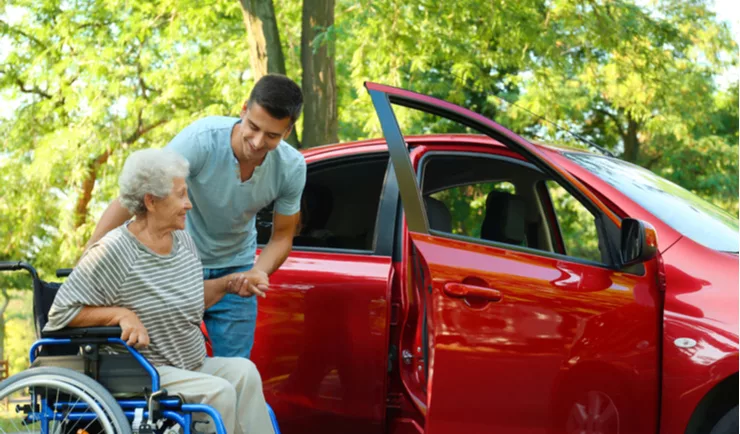What is Non-Emergency Medical Transportation?
Non-emergency medical transportation (NEMT) was first offered as a benefit in the 1966 US Medicaid program. The federal and state governments cover rides for eligible individuals to and from doctor’s offices, hospitals and other medical facilities for Medicaid-approved care. Originally the benefit was for low-income beneficiaries who didn’t have a reliable, low-cost method of transportation to health care appointments, had long travel times in rural areas, lacked public transit options, or had disabilities.
Today, states have different rules about who is eligible to receive rides, what rides are covered and if trips need to be pre-approved.
The most common health care services that people access using NEMT are behavioral health services, dialysis, preventive services, specialist visits, physical therapy, and adult daycare.
Some estimates say that about 80 percent of the Medicaid population can travel independently without assistance, but there is still a large portion that needs extra help from
drivers. This extra assistance could mean help to and from the door or requiring a traveling companion due to behavioral issues. Non-ambulatory passengers may need special transportation accommodations like wheelchair or stretcher transport, which require different types of vehicles. NEMT service providers assess each trip request to determine the least costly, most appropriate mode – should that be a sedan, medical transport vehicle, wheelchair van, taxi, public transportation, or mileage reimbursement.
How NEMT Differs from Ambulance Services
The name tends to give it away, but NEMT isn’t used in life or death emergency situations to transport people to the emergency room by ambulance or medical flight.
Why Is It a Medicaid Benefit?
These often-cited statistics sum up the enormity and scope of the problem:
- Approximately 3.6 million Americans miss or delay non-emergency medical care every year because of transportation barriers.
- And these no-shows cost the US health care system an estimated $150 billion in lost revenue per year.
The underlying principle is that spending money on NEMT services upfront to help people with limited transportation options get to their medical appointments prevents worsening or emergency health outcomes that cost the system even more money.
Is NEMT Only Provided for Medicaid Beneficiaries?
Forty-two programs across six US federal departments provide NEMT funding, but the most commonly known programs are Medicaid, Veterans Affairs, Medicare Advantage
insurance plans, and the Program of All-Inclusive Care for the Elderly (PACE). You can read some of our other in-depth articles about funding and service delivery for these alternate models.
Traditional Broker-Provider Model and NEMT Software
The NEMT industry is organized around the Medicaid program, with the traditional model being a Broker-Provider setup. There are many different variations of this model, but we’ll stick with this one for simplicity.
States or large funders (like Managed Care Organizations) will contract with a brokerage. The broker will manage the transportation benefit for beneficiaries in a geographic
area for a capitated fee. NEMT scheduling and dispatching software helps brokers manage all these different administrative tasks:
- Sub-contract trips to local transportation providers to perform the actual transportation services
- Negotiate rates
- Manage provider credentials and ensure they comply with regulations and inspections
- Operate the call center (aka reservation center) that beneficiaries call into to book and schedule all rides
- Handle administration of billing, member eligibility, and trip pre-approval
- Conduct investigations into complaints
The local transportation provider will maintain a fleet of vehicles and drivers, and may compete with other providers to fulfill trips that beneficiaries have requested through the
broker. Like taxi drivers, NEMT drivers are only given the pick-up and drop off time and location in order to protect a member’s private health information. A provider’s daily list of trips can be bulk downloaded from the broker’s NEMT software system into theirs.
Providers can use in-vehicle hardware that connects with the broker’s NEMT system in real-time. In-vehicle hardware could be a mobile data terminal or a proprietary app loaded on a tablet or mobile device that tracks the GPS location of the vehicle, provides navigation and an electronic manifest. After the trip is performed, trip completion data is sent back to the broker for billing and reporting. Providers and drivers can also choose to pick up will-call return trips and other last-minute trips if they have availability.
The final components of NEMT software are member self-service tools. With the growth in online appointment booking and notification systems, members are growing increasingly impatient with having to wait on hold to book trips. Online booking and trip management portals allow members or delegates to book their own trips, while notification systems remind them of upcoming trips by text, email or voice call.
NEMT software that connects passengers, providers, and brokers in real-time is helping revolutionize the NEMT industry. Health care payers and transportation providers need to provide service as efficiently and cost-effectively as possible while improving customer experience to keep up with increasing expectations.
